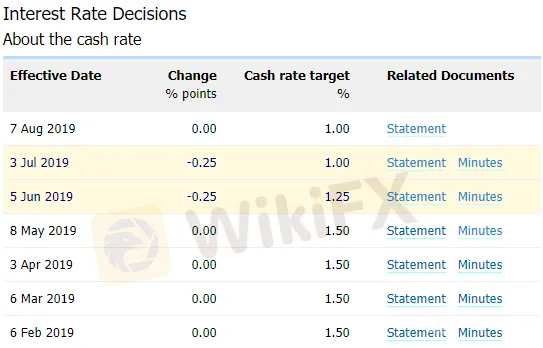简体中文
繁體中文
English
Pусский
日本語
ภาษาไทย
Tiếng Việt
Bahasa Indonesia
Español
हिन्दी
Filippiiniläinen
Français
Deutsch
Português
Türkçe
한국어
العربية
AUDUSD Rate Outlook Clouded by Mixed RBA Rhetoric
Abstract:AUDUSD struggles to hold its ground amid the threat of a US-China trade war, but there seems to be a rift within the RBA amid the recent batch of mixed comments.
Australian Dollar Talking Points
AUDUSD pares the advance from the monthly-low (0.6677) as the Peoples Bank of China (PBoC) continues to weaken the Yuan reference rate, and current market conditions may continue to drag on the exchange rate amid the growing threat of a US-China trade war.
AUDUSD Rate Outlook Clouded by Mixed RBA Rhetoric
AUDUSD struggles to hold its ground amid little indications of an impending US-China trade deal, and it seems as though the PBOC will allow the Chinese Yuan to depreciate against its major counterparts as Deputy GovernorPan Gongsheng pledges to “implement a managed floating exchange rate system based on market supply and demand.”
It remains to be seen if the US-China feud will lead to a currency war as the PBOC insists that it “will not engage in competitive devaluation and will not use the exchange rate as a tool to deal with international trade disputes,” but the weakening outlook for the Asia/Pacific region may push the Reserve Bank of Australia (RBA) to further insulate the economy as Assistant GovernorChristopher Kent insist that “financial market prices currently imply that the cash rate is expected to be reduced by a further 25 basis points later this year and then again in the first half of next year.”

The comments suggest the RBA will continue to endorse a dovish forward guidance “with growth having slowed to a below-trend pace and inflation pressures subdued,” but it seems as though the central bank will stick to the sidelines at the next meeting on September 3 as Governor Philip Lowe warns that “there are certain downsides from relying too much on monetary policy.”
At the same time, updates to Australias Employment report may encourage Governor Lowe & Co. to retain a wait-and-see approach as the economy is anticipated to add 14.0K jobs in July, and signs of a resilient labor market may fuel a larger rebound in AUDUSD as it saps speculation for an imminent RBA rate cut.
Sign up and join DailyFX Currency Strategist David Song LIVE for an opportunity to discuss potential trade setups.
AUD/USD Rate Daily Chart

Keep in mind, the AUDUSD rebound following the currency market flash-crash has been capped by the 200-Day SMA (0.7068), with the exchange rate marking another failed attempt to break/close above the moving average in July.
With that said, the broader outlook for AUDUSD remains tilted to the downsideas both price and the Relative Strength Index (RSI) continue to track the bearish formations from late last year.
However, the string of failed attempts to close below the Fibonacci overlap around 0.6720 (78.6% expansion) to 0.6730 (100% expansion) raises the risk for a larger rebound especially as the RSI bounces back from oversold territory.
In turn, another move above the 0.6800 (61.8% expansion) handle may spur a more meaningful run at the former-support zone around 0.6850 (78.6% expansion) to 0.6880 (23.6% retracement), with the next area of interest coming in around 0.6910 (38.2% expansion).
Disclaimer:
The views in this article only represent the author's personal views, and do not constitute investment advice on this platform. This platform does not guarantee the accuracy, completeness and timeliness of the information in the article, and will not be liable for any loss caused by the use of or reliance on the information in the article.
Read more

AUDUSD Range Vulnerable to Dovish RBA Forward Guidance
AUDUSD may face a more bearish fate over the coming days if the Reserve Bank of Australian (RBA) prepares Australian household and businesses for lower interest rates.

Gold Price Forecast Remains Bullish as RSI Approaches Overbought Zone
The price of gold may continue to exhibit a bullish behavior as the Relative Strength Index (RSI) approaches overbought territory.

AUDUSD Monthly Range on Radar Ahead of Fed Economic Symposium
The monthly opening range sits on the radar for AUDUSD as attention turns to the Kansas City Fed Economic Symposium in Jackson Hole, Wyoming.

Crude Oil Prices Eye Monthly-High as US Delays China Tariffs
The price of oil extends the rebound from the monthly-low ($50.52) as the US delays the next tranche of China tariffs to December 15.
WikiFX Broker
Latest News
Why Are Financial Firms Adopting Stablecoins to Enhance Services and Stability?
Experienced Forex Traders Usually Do This Before Making a Lot of Money
Octa vs XM:Face-Off: A Detailed Comparison
When High Returns Go Wrong: How a Finance Manager Lost RM364,000
Bridging Trust, Exploring Best—WikiEXPO Hong Kong 2025 Wraps Up Spectacularly
Interactive Brokers Expands Crypto Trading with Solana, XRP, Cardano, and Dogecoin
Fidelity Investments Explores Stablecoin Innovation in Digital Assets Sector
Why More People Are Trading Online Today?
SEC Ends Crypto.com Probe, No Action Taken by Regulator
Broker Comparison: FXTM vs XM
Currency Calculator







